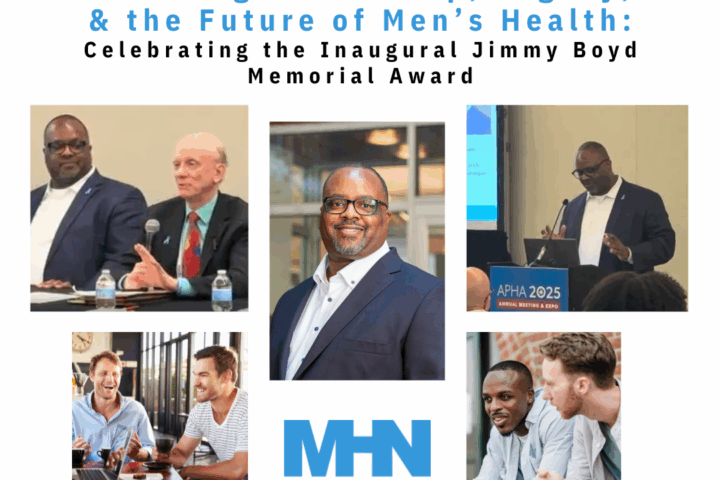A group of stakeholders dedicated to raising awareness on health disparities among American Indian and Alaska Native (AI/AN) males has collaborated with Men’s Health Network (MHN) and the Office of Minority Health to develop a brief report titled A Vision of Wellness and Health Equity for AI/AN Boys and Men.
Among American Indians and Alaska Natives (AI/AN), males experience alarming rates of illness and disease compared to their female counterparts and those often exceed rates for all other U.S. racial and ethnic groups. Unfortunately these health disparities among AI/AN males are probably worsening. Based on data compiled by the Indian Health Service (IHS), for some age groups AI/AN males experience death rates 200 to 500 percent greater than AI/AN females for suicide, HIV/AIDS, homicide, unintentional injuries, diabetes, firearm injury, and alcohol-related deaths and 10 to 50 percent higher than AI/AN females from cancer, heart disease, and liver disease.
“For generations we as American Indian and Alaska Native men have lived in pain and died much too early,” said Leo J. Nolan III, an enrolled member of the St. Regis Mohawk tribe, who spent 25 years working at IHS HQ and served as Senior Policy Analyst for External Affairs for the last 12 years. “It is time to redefine what it means to walk the path of a warrior in today’s world while respecting our traditions and cultures and to strengthen the important roles for our families and communities. Collectively we need our health and a sense of hope to do this. In essence our initiative is to determine how best to accomplish this and to secure the assistance to take action toward this journey to health and wellness that benefits all.”
Based on data from the National Health Interview Survey (NHIS), administered by the Center for Disease Control and Prevention (CDC), (https://www.cdc.gov/nchs/data/nhsr/nhsr020.pdf) AI/AN males experienced greater disparities in health status and general well-being than all other U.S. groups defined by the combination of race and gender. Further, AI/AN males experience higher self-reported psychological distress compared to AI/AN females, as indicated on responses to six questions contained in the NHIS. The greatest disparities were observed on two questions relating to how frequently AI/AN males felt “hopeless” and “worthless.” The suicide rates noted for these males confirms the devastating impact of these feelings of despair. This premature death of AI/AN males creates a crisis of loss for the mothers, fathers, wives, brothers, sisters, daughters, and sons while impacting not only this generation, but the next as well.
The reasons for health disparities among AI/AN men disparities are complex and remain poorly understood. The research that would lead to a better understanding of the causes of these inequalities, and test approaches to address them, has simply not been undertaken. Existing evidence suggests that social determinants such as historical trauma, loss of social roles and cultural connection, poverty, and unemployment may have greater adverse health effects on AI/AN men than women. To a large extent, no effective overarching efforts to study the root causes and develop AI/AN male-focused interventions have been put forward.
“Although these health disparities directly affect men, they also affect the entire family,” said Ana Fadich, Vice President Men’s Health Network. “The absence of a father and husband, or son, creates a void that everyone experiences. We need to better understand the underlying causes and subsequently identify best and promising practices to drive down the disparities differential. It’s not just an individual issue, it is a community issue.”
This report outlines a two-pronged media approach which will be coordinated by MHN with the intent to increase awareness of AI/AN male health disparities, including stakeholders from Capitol Hill to those in the most remote AI/AN communities. In cooperation with the IHS, a series of awareness-building Webinars targeting public health professionals and community leaders will kick off June 13 to correspond with Men’s Health Month. The initial Webinar will be followed with a monthly presentation focusing on the challenges presented by the disparities but also real-world solutions working in the Native American community.
Depending on the funding, a compelling and informative video documentary on AI/AN male health disparities in conjunction with Native American Heritage Month in November will be part of the outreach for 2013. As now envisioned, the video would be narrated by an AI/AN health professional/healer with support provided by a multi-generational group of recognized AI/AN advocates and role models that will include Billy Mills, 1964 Tokyo Olympics gold medalist and life-long advocate for Native American health. The goal is to harness the power of media to function as a catalyst for coordinating the diverse interests and concerns of AI/AN stakeholders – male and female – into a concrete plan of action for securing support for the research and pilot testing of interventions needed to realize health equity for AI/AN males and their families.
The report is now posted on the Men’s Health Network website and it can be downloaded here.
About Men’s Health Network
Men’s Health Network (MHN) is a national non-profit organization whose mission is to reach men, boys, and their families where they live, work, play, and pray with health prevention messages and tools, screening programs, educational materials, advocacy opportunities, and patient navigation. Learn more about MHN at www.menshealthnetwork.org and follow us on Twitter @MensHlthNetwork.



